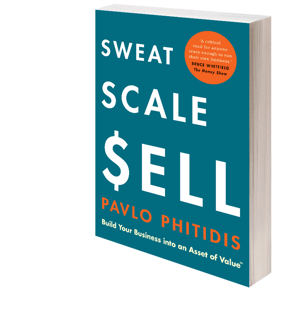Firstly, this only matters for 5.4% of all #businessowners since 94.6% of all business
Start now to prevent these fateful outcomes by taking control of two things. Understand how

1. Understand your business
The type of business you have, how long its been going, the
2. Understand your choices
If you have lived through your business and have very different income statements, you will pay the price in valuation at the end. If you have run thin and held back on investments needed to sustain the growth in your business, it will be noticed and evaluated and hurt the final price. Build with a view to
3. Understand your buyer
How competitive is the market for your business? Are there many
4. Understand valuation
There
DISCOUNTED FREE CASHFLOW (DCF)
This requires you to build a business into an asset. An asset is something that can be sold, that a buyer wants and wants it because it will provide two types of return. A capital return i.e. its equity value will grow and a cash return i.e. it will generate dividends. There are cases where certain assets only ever offer a capital return but that is seldom the case with a business as a living breathing thing. Capital returns are mostly for inanimate assets like art or diamonds etc.
There are essentially three levers that a business owner can control to improve the valuation of a business using the DCF.
THE RISK RATE LEVER
A high-risk rate drops your valuation. The risk rate seeks to measure the risk the business carries. Essentially, it looks to understand what makes your business special. It measures this against competition mostly and how sustainable your business is. For example, if you think that what makes you special is your product or service or price, you’re in for a big surprise. 100 years ago, your product could have set you apart but today, your competitors mostly have something similar and if not, will have it in the very near future. However, if you have a patent, this might set you apart but mostly not. There are millions of patents and very few in the world of the SME have any true, sustainable product feature advantages. Today, what makes you special is mostly linked to the specialisation of your business measured in terms of the problems you solve for well-defined customer segments.
THE DURATION LEVER
How long can the business continue without you – a year, five years, more? The longer into the future your business can operate the way it does, but without you, the higher the valuation. Get this right by building your business into a System of Delivery. That means your business functions are systematised to deliver a consistent experience in solving a problem for
THE FREE CASH LEVER
How much free cash does the business produce now and into the future. The thicker the seam, the higher the value, The more diverse the seam, the higher the value. Getting this right need discipline. All your innovation and growth acceleration efforts need to align
NETT ASSET VALUE (NAV)
This is commonly known as your book value. It looks at the net asset value of your business. that is, all assets depreciated plus all other assets less all liabilities. In well-established
MULTIPLE OF REVENUE
This method is used and most useful in cash businesses but only if there are reliable benchmarks for that business. you apply a multiple on the revenues and then hope for the best. With good benchmarks of, say
5. Understand your terms
I’ll leave you with one thought. A JSE listed company, EOH went on a wild SME buying spree for about 6 years until a year ago. Their share price was growing and full of heat and they did deals that split the purchase price between shares and cash. Mostly shares. Sellers sold and got paid in some cases with up to 80% shares. At that time, the shares were valued at around R150. Today, they sit at R14.50. Say you sold your business for R30m on an 80% share split. At the time you got R6m cash and 160,000 EOH shares. Today, this means you sold your business for R8.32m!
Build with passion and purpose. Your purpose should be to build your business into an #AssetofValue. This will safeguard your future, put you in the minority of businesses that sell with success and get a premium value at that. At Aurik, we’ll work with you to get this done. Its what we do and love making your success our moments of pride!
Click on the book to get your copy of Sweat Scale $ell which shows every business owner, entrepreneur and budding entrepreneur who has the right mindset, where to find growth in a no-growth economy.

